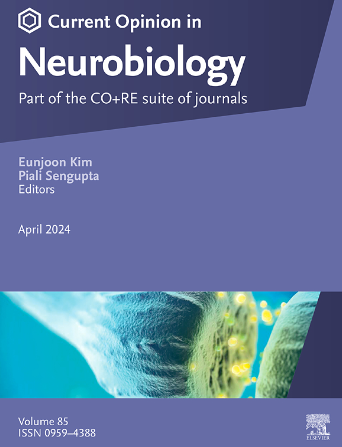Eligibility traces as a synaptic substrate for learning
IF 5.2
2区 医学
Q1 NEUROSCIENCES
引用次数: 0
Abstract
Animals can learn to associate a behavior or a stimulus with a delayed reward, this is essential for survival. A mechanism proposed for bridging this gap are synaptic eligibility traces, which are slowly decaying tags, which can lead to synaptic plasticity if followed by rewards. Recently, experiments have demonstrated the existence of synaptic eligibility traces in diverse neural systems, depending on either neuromodulators or plateau potentials. Evidence for both eligibility trace-dependent potentiation and depression of synaptic efficacies has emerged. We discuss the commonalities and differences of these different results. We show why the existence of both potentiation and depression is important because these opposing forces can lead to a synaptic stopping rule. Without a stopping rule, synapses would saturate at their upper bound thus leading to a loss of selectivity and representational power. We discuss the possible underlying mechanisms of the eligibility traces as well as their functional and theoretical significance.
适性是学习的突触基础
动物可以学会将行为或刺激与延迟奖励联系起来,这对生存至关重要。为弥补这一差距提出的一种机制是突触资格痕迹,这是一种缓慢衰减的标签,如果随后有奖励,可以导致突触可塑性。最近,实验已经证明在不同的神经系统中存在突触资格痕迹,这取决于神经调节剂或平台电位。有证据表明突触功能的合格性、痕迹依赖性增强和抑制都存在。我们讨论了这些不同结果的共性和差异。我们展示了为什么增强和抑制的存在是重要的,因为这些相反的力量可以导致突触停止规则。如果没有停止规则,突触就会在上界饱和,从而导致选择性和表征能力的丧失。我们讨论了资格痕迹可能的潜在机制,以及它们的功能和理论意义。
本文章由计算机程序翻译,如有差异,请以英文原文为准。
求助全文
约1分钟内获得全文
求助全文
来源期刊

Current Opinion in Neurobiology
医学-神经科学
CiteScore
11.10
自引率
1.80%
发文量
130
审稿时长
4-8 weeks
期刊介绍:
Current Opinion in Neurobiology publishes short annotated reviews by leading experts on recent developments in the field of neurobiology. These experts write short reviews describing recent discoveries in this field (in the past 2-5 years), as well as highlighting select individual papers of particular significance.
The journal is thus an important resource allowing researchers and educators to quickly gain an overview and rich understanding of complex and current issues in the field of Neurobiology. The journal takes a unique and valuable approach in focusing each special issue around a topic of scientific and/or societal interest, and then bringing together leading international experts studying that topic, embracing diverse methodologies and perspectives.
Journal Content: The journal consists of 6 issues per year, covering 8 recurring topics every other year in the following categories:
-Neurobiology of Disease-
Neurobiology of Behavior-
Cellular Neuroscience-
Systems Neuroscience-
Developmental Neuroscience-
Neurobiology of Learning and Plasticity-
Molecular Neuroscience-
Computational Neuroscience
 求助内容:
求助内容: 应助结果提醒方式:
应助结果提醒方式:


